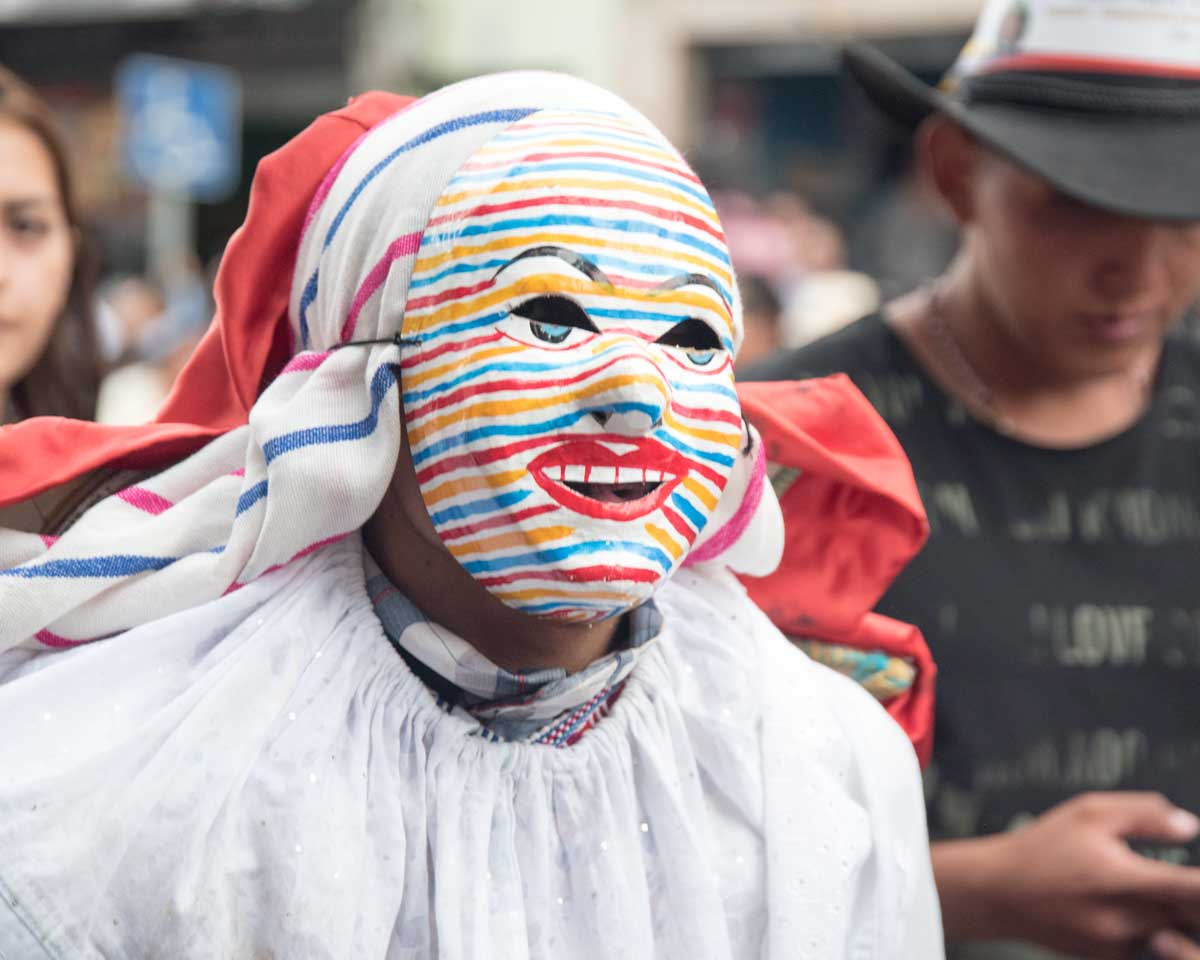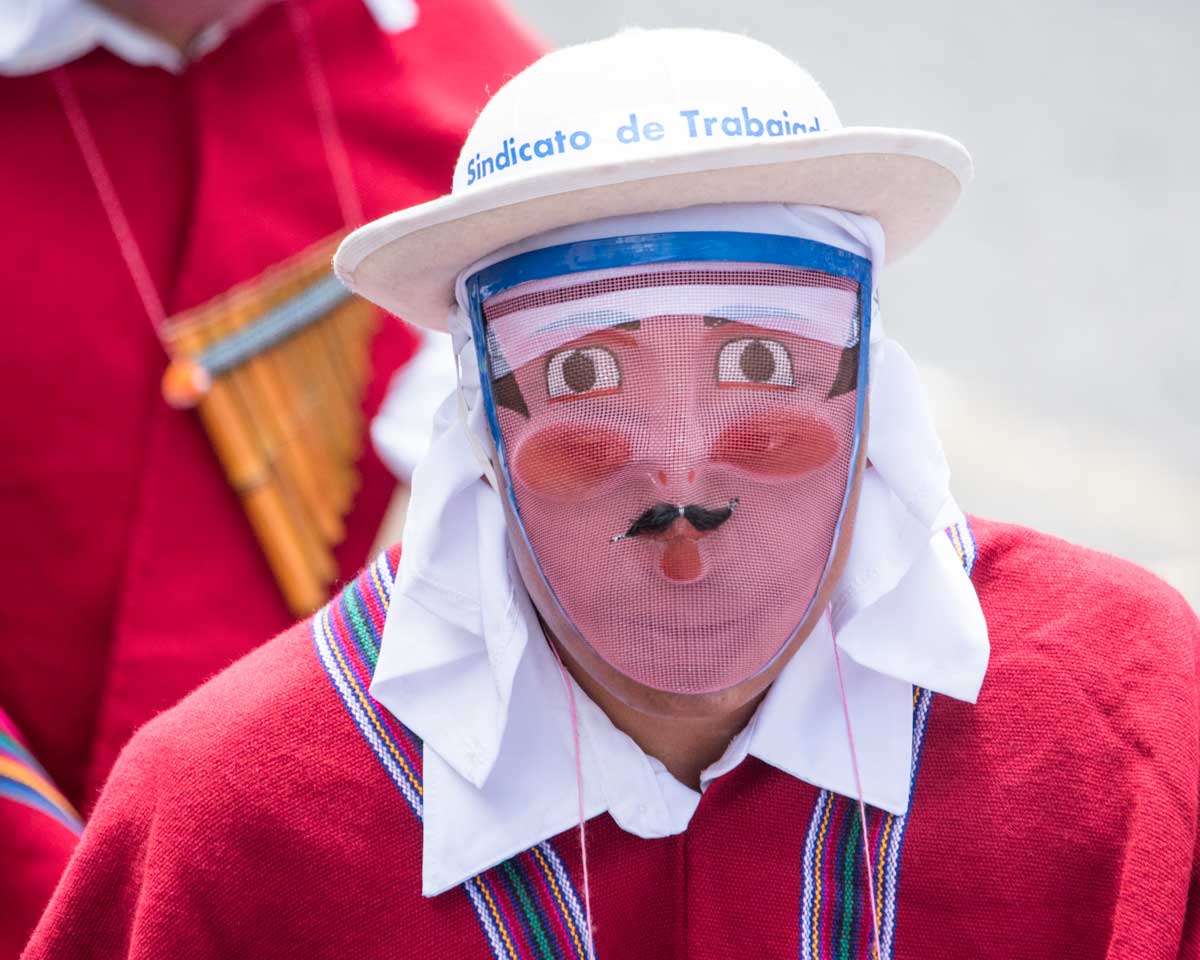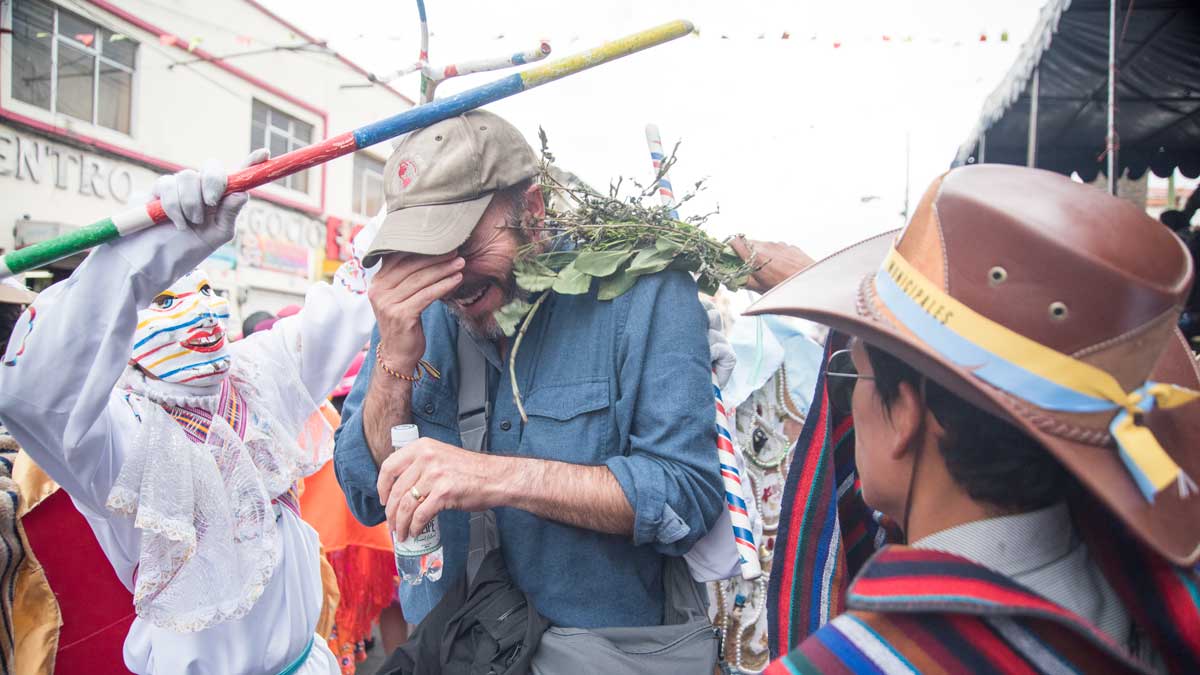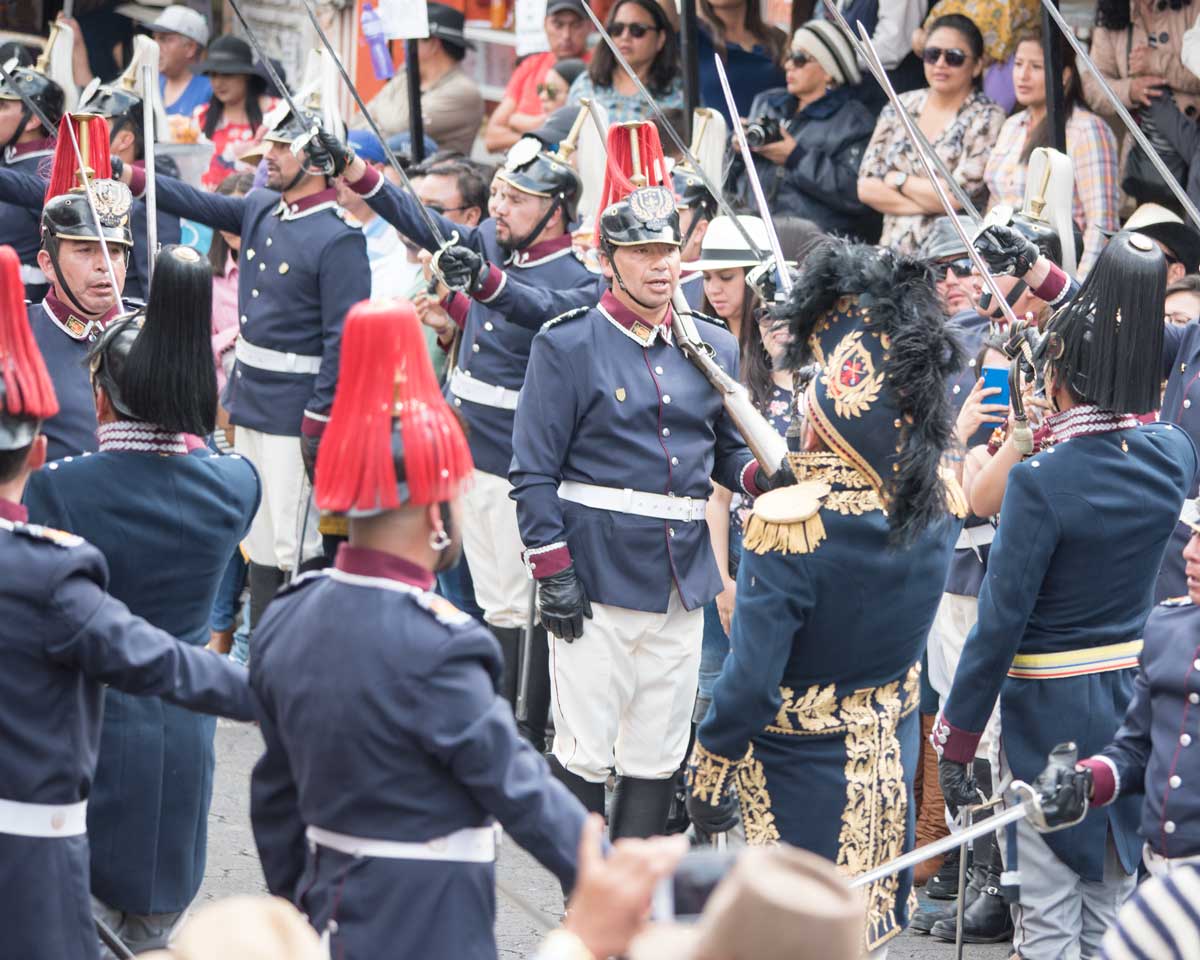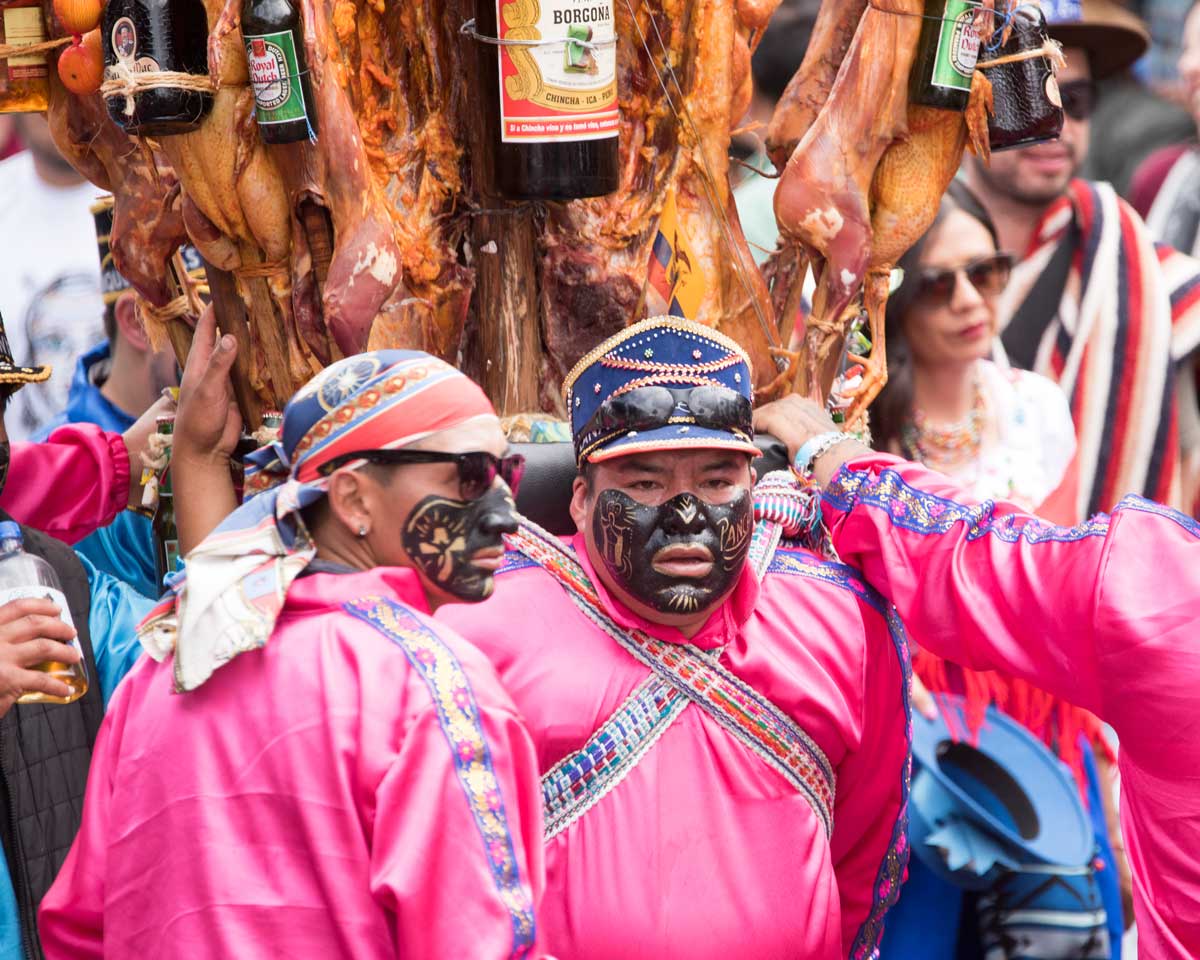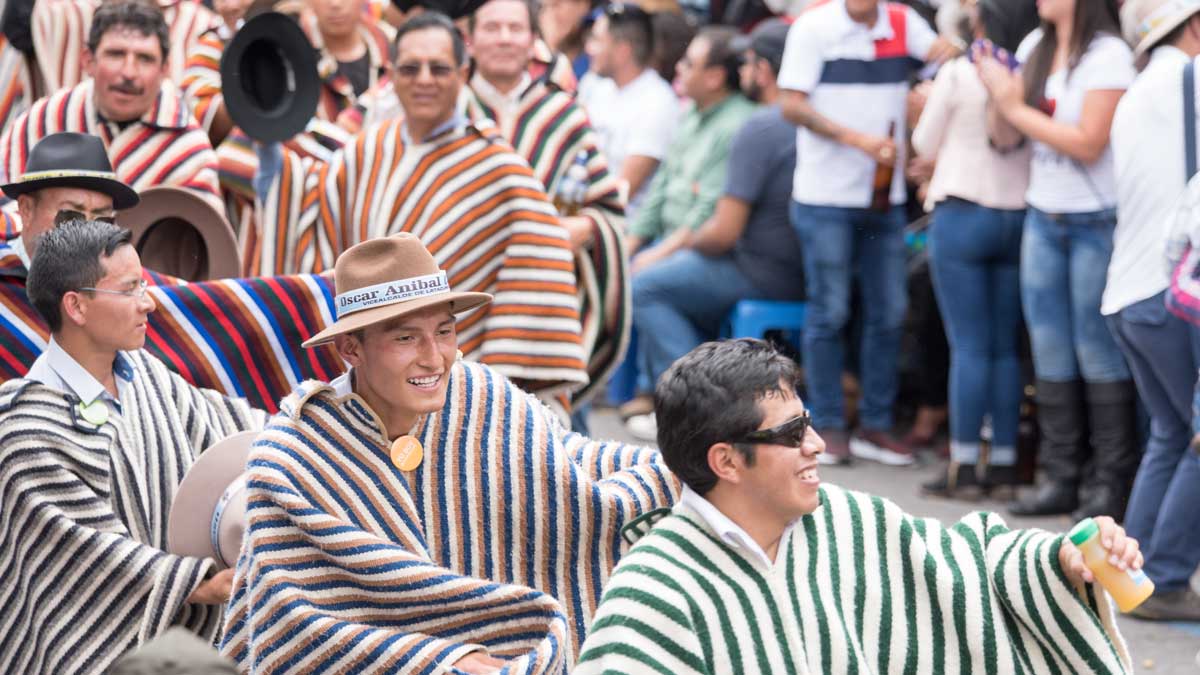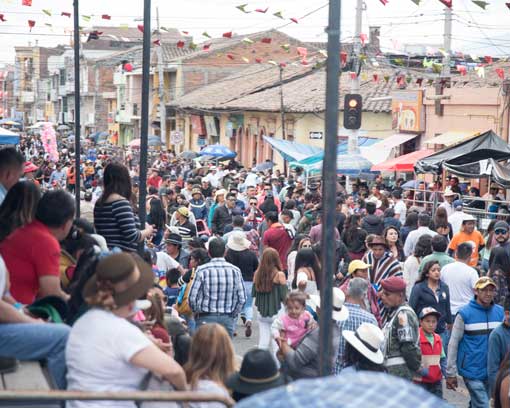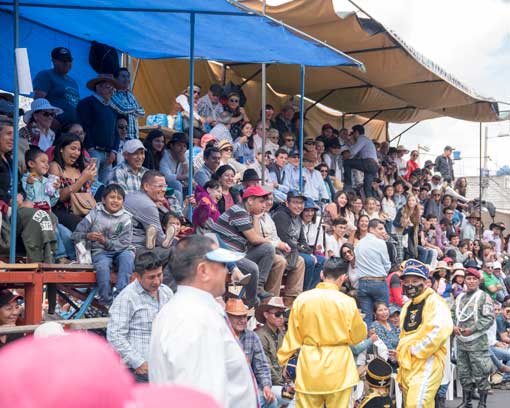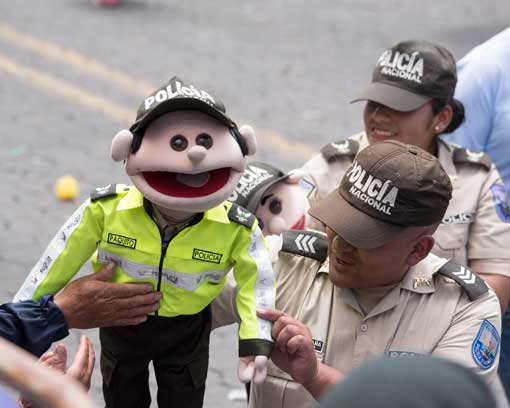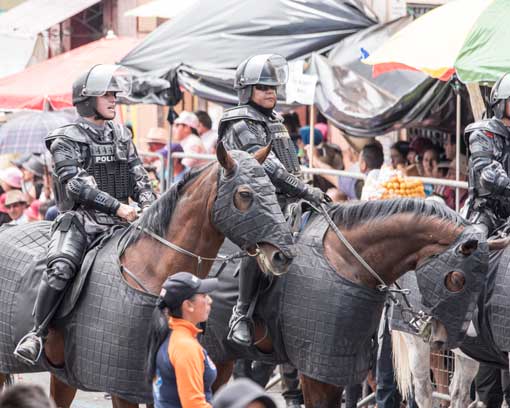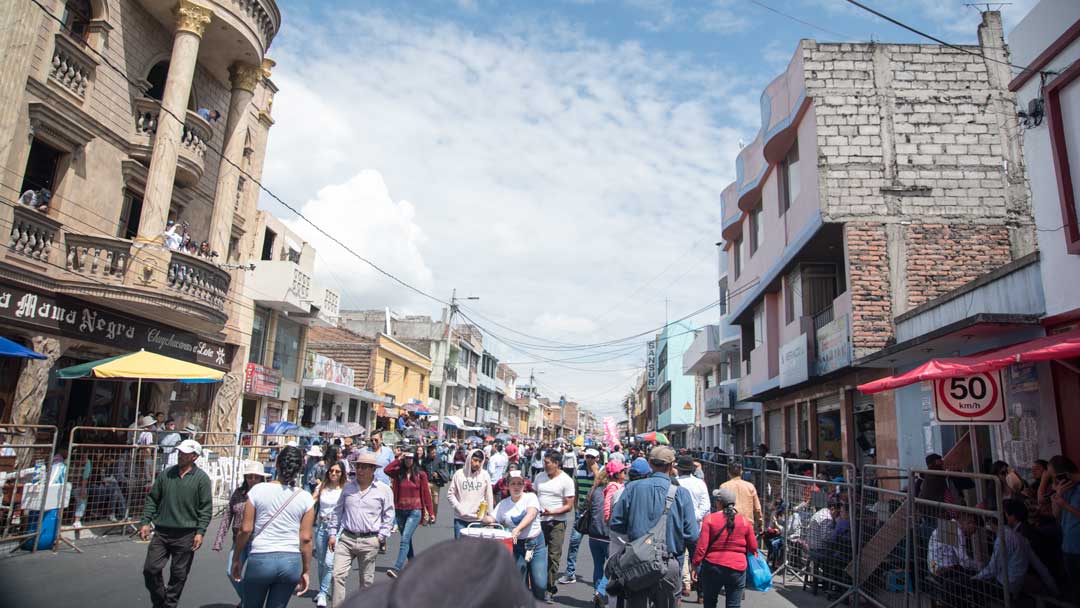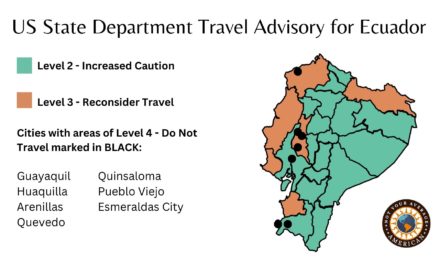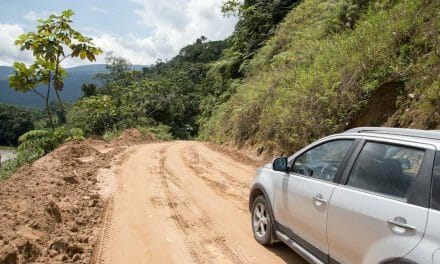First published on September 27, 2025 • Last updated on December 5, 2025
This page may contain affiliate links; if you purchase through them,
we may receive a small commission at no extra cost to you.
So you want to visit Latacunga to see the Mama Negra parade? But you can’t find any information. You’ve come to the right place. In 2019, we attended the November festivities with local friends and learned a ton about the do’s and don’t of the day. Read on to learn how to survive a day on the streets of Latacunga during the Mama Negra Parade!
What is Mama Negra?
Mama Negra is a festival that takes place each November in the medium-sized town of Latacunga, in central Ecuador.
Its namesake character is a large, black woman, dressed in elegant silk skirts. She rides a proud horse while holding a small puppet in one hand and a vial of milk in the other. As she parades through the crowded city streets, she blesses the crowd, smiling and nodding along for a route that can take more than four hours to complete. The people absolutely love her and the crowds go wild!
What many visitors don’t realize is that the person under Mama Negra’s facade is never a woman and has never been black. Tradition holds that a highly regarded citizen, always a man, play the role. And while many from the United States will immediately point out the racism of a black woman being played by a white man in blackface, Ecuadorians as a whole see no issues whatsoever. In fact, being chosen to play the role of Mama Negra has long been a symbol of pride in the Latacunga community.
The Mama Negra Parade
The parade itself begins like many other parades in Ecuador, with dozens of dance groups and musicians playing traditional music on stringed instruments, wooden pipes, and deep, resounding drums. The Mama Negra Parade stands out because of the collection of characters that appear only in this region of Ecuador: The Archangel Gabriel as the Angel de las Estrella, El Rey Moro, El Capítan, and, of course, Mama Negra herself.
Even the parade participants have special roles, all with traditional responsibilities to the event. To learn more about these many roles, please take a look at these two articles:
- Mama Negra: A Photo Essay – photos with explanations of the main characters found in the Mama Negra Parade, including Mama Negra, the Star Angel, the Moorish King, and the Captain.
- Mama Negra: Supporting Characters– photos with explanations of the supporting characters found in the Mama Negra Parade, including Los Priostes, Las Cholas Ofrendas, Las Yumbadas, Las Camisonas, Los Loeros, Los Payasos, Los Huacos, Los Curiquingues, Los Capiriches, and Los Ashanguero.
The History of Mama Negra
Mama Negra’s history is oft-debated, even among locals. The most popular belief is that Mama Negra dates back to Spanish-colonial times when local residents were under constant threat of eruption from the Cotopaxi Volcano. The Spanish Catholic residents of the time prayed to the Virgin of Merced to protect them. Her Saint’s Day is September 24th, a date conveniently close to Killa Raymi, when native Ecuadorians celebrate the September Equinox. Likely, priests at the time were looking for ways to incorporate native celebrations with Catholic ones. Thus, the Mama Negra celebration was born.
The problem with this origin story is that it fails to address why the primary character of the celebration is a black woman.
The second theory appeared in 1948 in an article by Galo Maldonado and Ema Garzon for the magazine Dinamia. They proposed that a local business owner wanted to be the prioste, or host, of the festival but he was a miser. For example, he refused to pay his tithe to the church. Furthermore, he did not want to finance the party after the parade. Yes, even today the prioste is expected to pay for the after party! One night, a demon appeared before his eyes, a black woman warning him that if he did not come up with the funds to complete his promise, he would be punished. But the story ends there… no explanation of how an apparition in a nightmare became the beloved Mama Negra.
The Most Likely Theory For Mama Negra
The third theory is my personal favorite. We first heard it from Rafael Camino Collantes, the owner-operator of Jacchighua, the dance troupe that keeps Ecuadorian traditions alive in Quito. He told us that the origins of Mama Negra hark back to the darkest days of slavery when the Spanish criollos marched enslaved black men and women from Latacunga to Sigchos to work in the mines.
Horrified, the people of Sigchos sent their prayers to the Virgin of Merced. After Ecuador abolished slavery in 1852, Mama Negra was born. An image of a freed black woman with control of her own fate blended that of the Virgin herself. The parade is a symbol of the Virgin leading the people to freedom. Perhaps it is this reason that many parade participants wear blackface. They represent the former enslaved peoples of Ecuador.
Why Are There Two Different Mama Negra Celebrations?
If you have done any research on the Mama Negra celebration, you have probably run into references of the September celebration as well as the November parade. According to the aforementioned Rafael, the September parade is the purer of the two celebrations. Hosted by indigenous Ecuadorians, this version claims to be the original. Obviously, its September date places it near the Killa Raymi equinox festivities. We have not attended this event and cannot give explicit advice for attending. Maybe next year!
Latacunga’s city elders host the November event. Many consider it a mestizo event. Rafael felt that the city celebration co-opts a native celebration. However, the second Mama Negra parade has a long history of its own. It’s especially beloved by Ecuador’s military. The Air Force and the Army each have their own contingent in the parade as do many local politicians and government officials. While it may lack indigenous authenticity, it is definitely well-attended by many who were born and raised in Latacunga.
What Time Should I Arrive For The Parade?
Plan to arrive early in the morning to avoid road closures and to find a place to sit. We arrived rather late, after 10 am, because we breakfasted at the popular Cafe de la Vaca. Despite police attempts to redirect our vehicle several times, we managed to work our way towards the parade route and park fairly closely. However, I don’t recommend this for the average visitor. We were helped along by a local who was able to finesse the local police. Not everyone can manage that act. You need to arrive no later than 9 am to avoid traffic jams and closed roads.
Seating is another reason to arrive fairly early. While the parade route is long, it is also full of people. Many locals set up seats in front of their residences or places of business. Those seats are usually reserved for families and friends. Schools and the military set up large, elevated seating of several tiers for their guests. We were fortunate to have a place reserved for us in one of those tiers. That isn’t the case for the average tourist. If you decide to give this a go, arrive early to find the best location. Be prepared to a dollar or two to rent a seat from a vendor. Additionally, for a little more money, you might rent a viewing spot from a second-floor balcony. Alternatively, you could work with a local tour guide to see if they can reserve a prime spot before the day itself.
How Long Does the Parade Last?
Nowadays, the parade can last a few hours. Be warned, Mama Negra arrives only after hundreds of others have danced past, many throwing sweets into the crowd, others offering shots of strong liquor, all dressed in brightly colored local costumes. We watched four hours of dancing, drinking, and all around merry-making before we caught a glimpse of Mama Negra. That did not include the time before we actually sat down. Come prepared for a long day.
What Should I Bring To The Parade?
Our recommendation is to carry a light bag with heavy strap that can be worn across your body – not a backpack. You will want to balance being prepared for the day with not carrying so much that you become a target of thieves or pickpockets.
In that light bag you will want to include:
- Snacks
- Bottled water
- Hat or other shade protection (umbrellas can be handy but can also cause neighbors to be upset for you blocking their view of the route)
- Rain gear (remember, this is the Andes where rain storms can appear out of nowhere)
- Camera
- Cellphone (yes, your cellphone should be kept in a bag, not in your pocket)
- Small change for tipping Los Huacos if you decide to be blessed (50 cents seems fairly standard)
- Small bills ($5 or less) to make food or drink purchases from vendors
Staying Safe Before, During, and After the Parade
Like any parade anywhere in the world, there are safety concerns. What is unique at Mama Negra is the amount of alcohol. It rivals Ecuadorian Carnival. Therefore, be prepared to face your fair share of drunkards. While most are benign, some can be belligerent.
Pickpockets are common at events like these. They tend to work in teams with one person working to distract you from the front or side and the second person robbing your pocket on the opposite side. A friend of ours videoing the parade actually had his cellphone stolen from him that day. On the other hand, his video equipment, including a drone, weren’t touched.
As you walk back after the parade, you will notice many drunks. Avoid being one of them is our first suggestion. You will be offered swigs of alcohol throughout the day. As a tourist, you have more leeway to say no or to only sip a little. Our second suggestion is to avoid interactions with groups of people who are obviously drinking to the point of idiocy. That brings us to our last suggestion.
Sit among the residents or where there are plenty of families with kids. While this doesn’t prevent drinking, its less likely that the you will have to deal with true drunkenness.
Where Should I Stay To See Mama Negra?
The city fills up for the weekend of Mama Negra. So if you haven’t booked your rooms early enough in advance, you still have options. To the north, Quito is only a couple of hours in good traffic. To the south, you’ll find the city of Ambato fairly close, then Baños and Riobamba a little further away. All are possible for a day trip with a driver to Latacunga. There are also some hacienda-style lodges in the Cotopaxi area that may offer deals that include transportation to and from the parade. It never hurts to ask!
If you have any questions, leave them in the comments below. We’ll do our best to provide quick answers!





